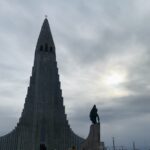A first peek
When I left the hostel with a few hours to kill before check-in, I steered towards the famous and impossible-to-miss church on top of the hill, the Hallgrimskirkja (Hallgrim’s church). Before I had time to take in the large group of people on the square in front of the church, a young woman approached me and asked if I wanted to join the protest. Upon enquiring what her name was and the purpose of this demonstration, Freya explained that the Icelandic government was apparently deporting Venezuelan refugees, who struggled to get their social security number, “into their sure death”. I thanked her for the information but decided to not join the protest. However, it shed some light on why so many employees at the hostel spoke Spanish.
Instead, I escaped the cold wind by entering the church. Like the outside, the inside was simple, grey and refreshingly simple, which highlighted its impressiveness. Especially the organ, towering over the entrance, was so vast it already looked loud. I shortly considered buying a ticket to visit the church’s tower (1300ISK/8.90€/7.70£) but decided against it. Maybe another time. At night, the church was illuminated in purple/pink as October was Breast Cancer Awareness Month.
In front of the church, the Viking Leif Erikson watched over the city in a heroic pose. The “son of Iceland” apparently not only discovered Finland but also America – around 500 years before Christopher Columbus. Interestingly, the US gifted the statue to Iceland in 1930, 13 years before the building of the church even began.
Leaving both behind, I began to make my way down the high street (Skólavörðustígur/School guard path), finding that the bottom end of the street was beautifully painted in rainbow colours. Icelanders are not only tolerant of mythical creatures like elves or trolls sharing the earth, but they are also happy to let humans be as diverse as they come. In 2015, the street was decorated for the annual Pride Day and has been a symbol of tolerance ever since, giving it the name Rainbow Street.
Interestingly, I noticed many toilet doors showed both female and male icons – another sign of the locals’ tolerance and an elegant and simple solution to the discussion who can use which bathroom.









